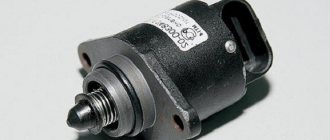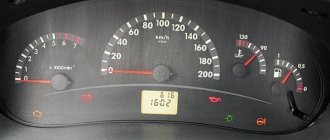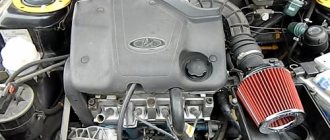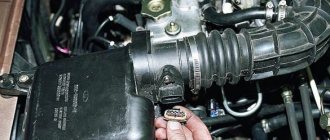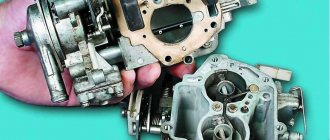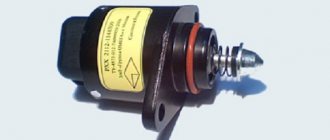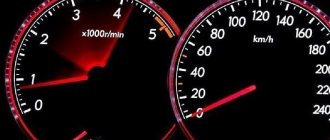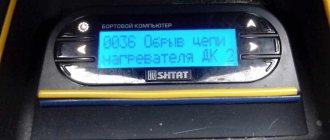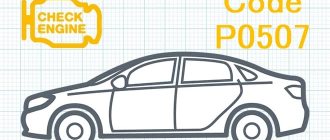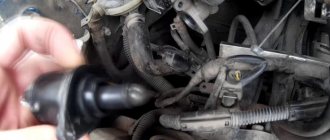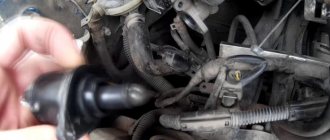The VAZ 2107 is not the best model among cars in its class when compared with foreign equivalents. However, thanks to its low price and accessible service, the car has been popular throughout the post-Soviet territory for many years. The car was produced from 1982 until 2014. That is, the oldest model is more than 30 years old. During such a period of operation, the owner will be able to encounter all types of faults and investigate most of the causes of problems.
After several years of operation, the VAZ 2107, as well as the almost identical model 2105, begins to show a new character with changes not for the better.
Malfunctions associated with the power unit and its body kit are of a different nature, but are symptomatic:
- the engine stalls periodically;
- does not maintain stable speed;
- unstable operation at idle;
- hard to start;
- insufficient power;
- increased fuel consumption.
All malfunctions appear for two reasons: violation of adjustments or wear of parts.
Prevention of injector breakdowns
Why an injection engine won’t start and how to fix possible problems is now known to all readers of our resource
. However, it is better to avoid such breakdowns, so let’s pay attention to ordinary procedures that, if carried out systematically, will help minimize the risks of all malfunctions. The simplest but most effective prevention consists of the following measures:
- Firstly, refuel exclusively at proven gas stations and only with high-quality fuel. Remember that most fuel system and engine malfunctions are caused by dirty gasoline;
- Secondly, change all consumables on time and only with high-quality products. The most important thing is periodic replacement of all kinds of filters and engine oil;
- Thirdly, periodically check the main components of the machine for stability. The list of the latter, naturally, includes the injector, elements of the fuel system, ignition and engine;
- Fourthly, never neglect routine diagnostics of your car at a service station. Surprisingly, even a delay of a couple of hundred kilometers can cause serious damage, which previously could have been eliminated with very simple actions;
- And fifth, always operate your vehicle properly. That is, you do not need to overheat, overload or negatively impact your car in any other way.
Perhaps this is where the most important information on today’s issue has come to an end. We hope the material presented above was useful and provided answers to your questions. Good luck in operating and maintaining your car!
Features for injector and carburetor
The idle speed regulator (sensor) belongs to the fuel system of an internal combustion engine with distributed injection. The purpose of the part is to open the air pipe into the receiver when the throttle valve is closed within strictly defined limits.
Structurally, the IAC on the VAZ 2107 is an electric motor, which consists of a stator, a magnetic rotor and a spring-loaded rod mechanism with a locking tip. The ECU sensor controls the opening of the damper to a certain area.
For carburetor engines, a different solenoid valve operation scheme is used. The regulator is installed in the carburetor; it is based on an electromagnet with a locking part. When voltage is applied from the ECU, the valve releases passage in the fuel nozzle.
The best
look at the fuel pressure in the rail, if there is a return line, see if gasoline is flowing from it, if it doesn’t, then there is no fuel pressure in the rail, look at the main relay, the fuel pump relay, the fuses, right the caps with it from them and look, maybe the main thing clicks for you and immediately hangs up or doesn't turn on at all,
see if the immobilizer is sewn into the firmware, flash the firmware from the ECU to the table and look, or replace it with another ECU, look for errors with a scanner,
look at the readings of the mass air flow sensor and the IAC (the latter can be checked by slightly opening the throttle valve)
Why does a VAZ injector car immediately start and stall?
Situations when a VAZ injector starts up immediately and then immediately stalls appear quite often. And all the rest due to the accounting fuel injection system (forced type). To correct this situation, car owners often use a heating plug, but this is not a solution to the problem, but only a temporary measure. If a VAZ 2107 starts and stalls immediately
after turning the key in the ignition, this almost always indicates a problem in fuel delivery (the fuel pump is clogged or not working correctly), or the quality of the fuel used is not sufficiently developed, and the injectors are simply clogged. And the car starts only with the remaining fuel in the cylinders.
Features of tuning carburetor engines
In the VAZ 2107 engine, the carburetor uses an undistributed fuel mixture supply circuit, there is no idle speed sensor as such in the system, the operation of the entire solenoid valve block is checked: jets, spring-loaded mechanism and power quality.
Malfunctions can be eliminated by flushing the carburetor, cleaning the jets and channels. It remains mandatory to adjust the fuel level in the float chamber and check the jets for compliance with the markings, since the parts have different sizes.
The cause of a stalled engine is the spark plugs
In 50% of cases, the problem is due to the fact that the spark plugs simply do not produce a spark. This failure occurs as a result of 3 reasons:
- contacts become clogged;
- plaque forms along the entire contour of the candle;
- malfunction when supplying voltage to the spark plug.
However, the most popular is still black carbon deposits on the spark plugs, which prevents the spark from appearing or causes it to work periodically.
If you see dirt on the surface of the contacts, this indicates the need to replace a low-quality type of fuel or check the serviceability of the oil supply systems. It is the oil supply adjustment sensors that can splash the spark plugs with it if there is a problem. Also, oil that appears on a set of spark plugs may indicate serious damage to components in the engine cylinders. Be sure to check the engine at a car service center. Otherwise, further operation may lead to expensive replacement of jet rods and even the entire set of pistons.
If you systematically use low-quality gasoline samples, you may find a red-brown coating on the contour of the spark plug. In this case, cleaning will not help - it is better to immediately replace the entire set after a new refill. If you find that the car periodically turns off at full speed, but starts easily even with clean spark plugs, then the problem lies in the electrical wiring.
spark plug
Checking the electro-pneumatic valve control unit.
You will find the control unit for the EPHH electro-pneumatic valve on the left mudguard in the engine compartment.
Gradually increase engine speed. At engine speeds of 1500–2000 rpm, the voltmeter readings will drop abruptly to 0.5–1.5 V or the warning light will go out.
We replace the faulty unit with a new one, for this...
4. ...disconnect the connector...
5. ...and use a screwdriver to unscrew the two screws securing the block to the mudguard. Next, we install the new EPHH block in reverse order.
Interruptions in the operation of the VAZ 21043 engine
- Registration
- Entrance
- To the beginning of the forum
- Forum Rules
- Old design
- FAQ
- Search
- Users
just as there are no rifles shot by someone and guitars tuned at the factory.
When the engine is warm, there are no problems with starting. Pressing the trigger while moving leads to obvious failures, especially hard when not warmed up.
Exactly. bioss
, first, unscrew the spark plugs and tell me what color they are. Everyone, of course.
factory tuned guitars
But we have always treated weapons too reverently.
That’s why in real life they carry out the final zeroing (I saw how graphs are built in this case, and then adjustments are made based on them - I expected a simpler approach)
but there are plenty of people who think that carbs can just be installed and used. You can’t use anything new - and the carb also needs to be adjusted.
After removing/installing the carburetor cover (OZONE) and purging the jets, the oil disappeared, the car jerks when starting to move and does not accelerate. I unscrewed the spark plugs and they were all black as night. I tried to regulate the speed - more or less stable speeds are obtained with the quality screw fully tightened
Have you adjusted the fuel level? Have you checked the needle valve?
when I removed the cover the level was normal (in the middle of the inclined platform). I checked the valve with a pear - it holds the vacuum. This is what I remembered: with the cover removed, I decided to see if the throttle valves fully open when the gas pedal is pressed. I locked the pedal in the pressed position and tried to move the drive, but I managed to move it just a little. So, couldn’t I have disturbed the adjustment of the locking screws that regulate the closing of the throttle valves?
Along the way, I’ll ask: Maybe someone knows a smart carburetor mechanic in the Yuzhnoye Butovo area, I’m just unlikely to get further.
So, couldn’t I have disturbed the adjustment of the locking screws that regulate the closing of the throttle valves?
when I removed the cover the level was normal (in the middle of the inclined platform).
After removing/installing the carburetor cover (OZONE) and purging the jets, the oil disappeared, the car jerks when starting to move and does not accelerate. I unscrewed the spark plugs and they were all black as night.
I tried to adjust the speed - more or less stable speeds are obtained with the quality screw fully tightened (although in normal mode the engine stalls with this position of the screw)
The car starts and immediately stalls: causes and solutions to the problem
Owners of VAZ 2107, 2110, 2112, 2114, and other cars, may encounter a problem - the car starts and immediately stalls. The engine starts, but after a few seconds the speed drops and the engine stalls. Let's look at possible causes of startup failure and ways to eliminate them.
First, you need to go through the most obvious options.
- Gasoline (diesel fuel) has run out. No matter how paradoxical it may sound, drivers often forget to monitor the level of fuel in the tank.
- On diesel engines (especially in winter), the reason that the car starts and stalls almost immediately can be frozen fuel.
- The quality of gasoline at gas stations is often appalling, so if you fill your car with low-quality fuel, you may encounter the problem of a stalled engine. If there is only a little bad gasoline, you can dilute it with good gasoline. But if the tank is full, then it’s better to drain the surrogate out of harm’s way.
- Worn wires and old (faulty) spark plugs are also quite often the cause.
- Engine compression, or rather its absence, can provoke a situation in which the engine stalls barely having time to “catch up”. But this is already a very serious breakdown, the appearance of which is accompanied by a host of other symptoms, which are simply impossible not to notice during the operation of the car.
- The injector starts and stalls
- Why do carburetor cars start and stall?
- Other reasons for incorrect starting of the VAZ 2107 engine
- Adjusting the fuel level in the float chamber (Solex carburetors)
Possible reasons why an injection engine does not start
Fuel system
It is necessary to diagnose the fuel supply system. In domestic fuel-injected cars, when the engine starts, you can hear a specific buzzing sound from the rear of the car. This sound indicates that the fuel pump is operating. Accordingly, if such a buzzing noise is not observed, most likely the problem lies in the pump.
You need to check the fuses that control the fuel pump, the main engine control relay and the fuel pump relay. In some cars of the VAZ family, fuses are hidden under the glove compartment, in others behind the heating panel cover on the passenger side. If the fuses are ok, check the relay.
You can touch it, and a specific click should sound. If the relay is also working properly, you need to check the pressure in the fuel system. The best way to do this is with a pressure gauge. If this is not possible, you will have to find a spool, which should be under a protective cap.
When you press it, you should feel pressure. Some models do not have a spool. Then you need to disconnect the fuel supply pipe. If the pump is working, then pressure should also be felt under your finger.
If it turns out that all elements of the fuel system are in order, then the next thing you should pay attention to is the ignition system
Ignition system
The main thing you need to be sure of is the presence of a good spark, that is, a discharge between the two contacts of the spark plug. If the starter turns, but the engine does not start, then there is a high probability of a malfunction in the ignition system. This is where we need our spark gap. If you check the spark plug without it, for example, by attaching it to the engine, then the resistance will be too high.
Therefore, we will not be able to accurately check our spark plugs and, in addition, the controller may be damaged. After checking the fuel system and ignition system and not finding the cause of the malfunction, you will need to check the engine. Most likely, this is the reason.
Starter malfunction
This can be a very common reason why the car engine does not start. In order to establish the possible cause of a starter failure, it is very good if the car enthusiast has at least an approximate understanding of the structure of this mechanism and how to check whether it is working.
It is important for owners of foreign cars to know that imported starters can stop turning even due to lack of lubrication or when dirty. In this case, the solution is very simple: remove the starter from the engine, thoroughly clean it from dirt and thoroughly lubricate the necessary mechanical components
Moreover, the used lubricant must be removed. In principle, this is not difficult, but if it doesn’t work out, then it’s better to contact a specialist.
Some starter malfunctions can be determined by ear. If you turn the key in the ignition switch, the starter makes a click, but it does not start, then most likely the relay is faulty. If possible, then you need to repair it. If the relay cannot be repaired, then it is worth replacing it. Only dismountable types of relays can be repaired.
Accumulator battery
The battery must be undamaged and the terminals clean and free of oxide, otherwise there will be no good contact between the battery and the vehicle's electrical wiring. The battery must have sufficient charge and “hold” it.
If the battery has been used for some time in undercharge mode, then there is a very high probability of deep discharge, in which it will no longer be able to recover.
Wiring
Corrosion may form on wiring elements or at connection points, which prevents the normal flow of current. All contact pairs must be clean and the connections insulated.
Injectors
Injectors in a car rarely fail all together and at the same time. Therefore, if there is a malfunction of one of the injectors, the engine will still be able to start and operate, albeit intermittently.
Crankshaft sensor
If this sensor is faulty, the engine will not be able to start. At the same time, the starter turns, but the engine still does not start. Failure of other sensors will not have such an impact that the engine will not start. To test the sensors, you should use a multimeter.
Finding the faulty component
So, what should you do if the engine starts easily, but then immediately slows down and stalls? The first thing you need to do is check for carbon deposits on the spark plugs. If some of them are covered with a layer of carbon deposits, then the engine a priori cannot operate normally. It first starts due to the movement of the starter, but immediately after that it brakes, since several cylinders are physically unable to withstand the entire load from the crankshaft. The carburetor, by the way, can also fail due to such a problem.
Cars with carburetor engines (VAZ 2101,2102,2103,2104,2105,2106,2107)
The reasons for this malfunction can be very diverse, but the 2 main ones are a malfunction of the fuel system and the ignition system. The search must be carried out step by step, then the desired result will be obtained. The reason for unstable engine operation is the over-enrichment or depletion of the fuel mixture entering the engine cylinders when the gas pedal is pressed. This should be taken into account when diagnosing faults.
Indirect signs by which you can determine the causes of unstable engine operation when you press the gas pedal.
1. When starting from a stop or idling, a “failure” is felt when you smoothly press the gas pedal. During acceleration and further movement, the engine runs stably.
2. While driving at low and medium speeds, when you press the gas pedal, the car jerks with a possible engine stop. This defect disappears when you press the gas pedal harder.
- Clogged channels, fuel nozzle, emulsion well with emulsion tube of the main metering system of the first chamber of the carburetor. It can be eliminated by cleaning and purging the channels and nozzle.
3. The engine stalls or there is a “failure” when you sharply press the gas pedal at idle, when starting from a stop, accelerating and moving the car at different speeds.
- The accelerator pump is faulty. Eliminated by disassembly, inspection and replacement of damaged parts from repair. set.
- Insufficient gasoline level in the carburetor float chamber. Eliminated by adjusting the position of the float.
If the fuel level in the carburetor float chamber is excessive, the mixture is greatly over-rich and entering the engine cylinders can “flood” the spark plugs. If the level is insufficient, the fuel mixture, on the contrary, is lean and when pressing the gas pedal, the engine does not receive the required amount of fuel and the car slows down instead of accelerating.
4. The engine stalls or a “failure” is felt when you sharply press the gas pedal. This malfunction occurs when the carburetor accelerator pump is faulty. First, you need to check the fuel supply to the sprayer by pressing the throttle valve drive lever (in this case, a portion of fuel should flow from the sprayer spout into the diffuser).
First of all, you need to remove the spark plugs and check their condition. On a working spark plug, the skirt will be light brown in color, and soot and deposits will be minimal. If the spark plug is smoked (black soot is present), this indicates that the engine is running on a rich fuel mixture. If the color of the spark plug is white with signs of overheating, then this indicates that the engine is running on a lean mixture. A wet spark plug indicates that fuel does not ignite in that cylinder.
A defective spark plug can be identified without removing it from the engine. To do this, with the engine running, you need to disconnect the high-voltage wires from the spark plugs one by one (while observing safety rules using dielectric gloves or electrical insulating material). If the engine stalls when the wire is disconnected, then the spark plug is working; if the operation remains virtually unchanged, the spark plug is faulty.
We check the condition of high-voltage wires. The insulation resistance of the current-carrying wire, measured with a multimeter, should be no more than 10 kOhm.
Check the condition of the ignition distributor cap. The inner surface of the cover must be clean, the contacts must be free of signs of corrosion and scorching.
The resistance of the ignition distributor slider resistor is 5 KOhm. Unstable engine operation when you sharply press the gas pedal may be due to wear of the connecting rod and piston group, or improper valve adjustment.
Carburetor adjustment
Adjusting the carburetor involves several steps:
- Adjust the position of the float as described above.
- Check and set the “quality” and “quantity” screws to the initial state. Screw them all the way and unscrew them 2-3 turns for the “quality” screw and 3-4 for the “quantity” screw.
- Connect a tachometer or auto tester to the “K” terminal of the ignition coil, and the second probe to the housing.
- Start and warm up the engine to a temperature of 90°C
- Use the “quality” screw to set the maximum idle speed. The gasoline supply increases when the screw is rotated counterclockwise.
- Use the “quantity” screw to set the speed higher, approximately 80-90 rpm.
- Using the quality screw, we determine whether these speeds are maximum; if not, then we repeat the procedure.
- If the position of the quantity screw does not affect engine speed, tighten the quality screw so that the speed drops by 800-900 rpm.
This carburetor adjustment may not be entirely accurate, but does not require special equipment.
Checking the IAC electrical circuit.
What can you do yourself when checking the electrical circuit of the idle speed control of a VAZ 2107? Measuring the voltage at the connection block to the control unit and measuring the resistance of the regulator motor windings. To measure you need to have a tester. The diagnostic procedure is given below:
- Disconnect the block with the wiring harness from the regulator. It is located on the throttle assembly.
- Turn on the ignition.
- Set the tester to voltage measurement mode in the range from 0 to 20 volts.
- Connect the probe from the tester with a minus sign to the ground of the car.
- Connect the probe from the tester with the “plus” sign in turn to terminals “A” and “D” on the harness block. The voltage between ground and terminals should be 12 volts. If there is no voltage, the controller may not be corrected.
- Next, move the tester to the resistance measurement position. Measure the resistance of the first winding between terminals “A” and “B”. Measure the resistance of the second winding between terminals “C” and “D”. There should be 52 ohms on both windings. In other variations of measurements between the terminals, the device should indicate an open circuit. If the tester shows the opposite, then the electric motor is faulty.
IAC malfunction.
The electric motor is not the only component in the regulator that can break; there are a number of other breakdowns:
- oxidation of connector contacts, broken wires;
- contamination of the rod, preventing movement;
- the o-ring is torn;
- wear of the screw thread on the rod.
Of the above breakdowns, the most common is contamination of the rod. If during operation the throttle assembly has not been maintained for a long time, carbon deposits on the regulator rod are possible. To remove dirt, you need to remove the IAC and rinse with acetone.
The stem needs to be cleaned periodically. Otherwise, the load increases, which can damage the ECU. Then you will have to contact service station specialists.
Problems in the mass air flow sensor - mass air flow sensor.
The mass air flow sensor is located in the air duct between the throttle valve and the air purification filter. It shows the volume of air entering from the atmosphere into the suction manifold. Based on these data, the control unit calculates the amount of fuel required for the current operating mode of the internal combustion engine.
If the sensor is faulty, the “Check Engine” light on the panel lights up. In parallel with this, a number of signs of failure are possible:
- Fuel consumption has increased.
- Idle speed is increased.
- The dynamics of the car are disrupted due to a decrease in power.
- It is impossible to start the internal combustion engine, even when “hot”.
- The speed changes at any throttle position, even under engine load.
Such sensors are not repaired, but replaced. Therefore, you need to make sure that this is the reason. Often the cause may be contamination of the platinum thread inside the device; it can be cleaned. Or the cause of air leakage through a damaged air duct.
Air leaks through cracks in hoses and seals.
There are many places where excess air can enter the suction manifold, bypassing the mass air flow sensor. The fuel mixture becomes leaner, the speed decreases, and the power drops. The ECU tries to correct these errors. A failure occurs in the system, the speed and “thrust” do not correspond to the specified parameters. The "Check Engine" warning light on the dashboard does not light up. The conclusion from this is that the sensors are working, but the internal combustion engine is sucking in air somewhere.
There are several places for air leaks that you should pay attention to, these are:
- the manifold with its gaskets, all kinds of joints, gaskets under the equipment attached to the manifold;
- vacuum brake booster and its hoses:
- throttle body;
- vacuum pipes.
After eliminating these shortcomings, the power unit will operate normally.
Other reasons.
A car is a complex engineering structure. During operation, its units, components, systems, and blocks are subject to wear. And it is impossible to describe all combinations of breakdowns.
Here are some reasons for the internal combustion engine not working properly:
- The ignition system has many of its own “sores”.
- Nozzles requiring professional care.
- Low quality gasoline.
- Presence of water in the fuel tank.
- Fuel and air filters are clogged.
- Other.
In each case it is necessary to understand, identify cause and effect. If you can’t do it yourself, you should contact a service station specialist.
In this article, “Why do idle speeds fluctuate on a VAZ 2107 injection engine,” the emphasis is on the breakdown of the XX Regulator. If it is broken, it can hardly be repaired. It's better to change it. It’s not difficult to do it yourself, having a new IAC and a minimum of tools.
Purpose and design of the idle speed controller.
The idle speed regulator is designed to regulate the amount of atmospheric air entering through the bypass channel (bypass) into the suction manifold when the engine is idling. The main channel is closed by the throttle valve.
The regulator is a DC electric motor. It has two windings on the stator and a rotor with permanent magnets. The rotor is connected to the rod by a lead screw. At the end of the rod there is a valve that closes the hole in the bypass. Power is supplied either to the first or to the second stator winding. At the same time, the rotor rotates in one direction and then in the other, extending or retracting the rod and the valve with it using a screw.
What carburetors are installed on the VAZ 2105
All carburetor installations equipped with the VAZ 2105 are focused, first of all, on minimizing fuel consumption. Of course, AvtoVAZ engineers throughout the history of the “five” experimented with the equipment of the car in order to identify the most effective mechanisms.
Over the years, various modifications of carburetors were installed on the VAZ 2105. All of them had both their advantages and disadvantages, which the drivers themselves often had to identify while driving.
Modification of DAAZ
The Dimitrovgrad Automobile Unit Plant (DAAZ) has launched the production of carburetor units under license from Weber. The main quality of DAAZ products is ease of operation and repair. The production of all parts necessary for repair and replacement was established, so if necessary, the driver could easily buy the necessary components and independently carry out the work of adjusting the carburetor.
DAAZ carburetors provided the car with increased speed characteristics, since the new nozzle system made it possible to react as quickly as possible to an increase in speed and supply the required amount of fuel to the engine.
A significant drawback of the Dimitrovgrad Automotive Unit Plant carburetor can be considered fuel consumption. In the combined cycle, the device required at least 10–14 liters of fuel per 100 kilometers.
The first VAZ 2105 cars were equipped with DAAZ carburetors
Modification "Ozone"
The Ozone carburetor is considered a modified version of the device that was assembled at DAAZ under license from Weber. "Ozone" is a more advanced version of the old "DAAZ". This carburetor has higher environmental friendliness, and also significantly reduces fuel consumption per 100 kilometers.
However, not everything is so good in the Ozone design. After numerous complaints from VAZ 2105 drivers, the designers identified a major drawback of this type of carburetor. The device is equipped with two chambers, but a pneumatic valve takes part in the operation of the second chamber. It was because of this that drivers had problems, since even with the slightest contamination the valve began to work incorrectly.
Carrying out diagnostics
The simplest method is to measure the voltage at the block to which the regulator is connected. These are terminals D and A. When the ignition is turned on, a voltage of 12 V should be present on them. If the voltage is less than this value, it is worth looking at the battery and generator. It is quite possible that the battery is undercharged. In the same case, if there is no voltage at all, it is necessary to check the entire power circuit of the device and diagnose the ECU.
Set the multimeter to resistance measurement mode. Between pairs of terminals A and B, C and D, there should be a resistance of approximately 53 ohms. Remove the IAC and connect (with the ignition off) to the block. Then turn on the ignition and look at the behavior of the needle - it should extend completely when voltage is applied. If this does not happen, we can judge that the IAC is broken.
Sometimes simply cleaning the regulator helps. To do this, you can use sprays, of which there are sufficient quantities in stores. But in some cases, only replacing the device will help. Of course, this is not a DAAZ carburetor, the cost of the IAC will be many times lower, and there will be no problems with replacement. If, even after the replacement, the engine does not idle, it is necessary to fully diagnose the injector.
The VAZ 2107 idle speed control is removed to replace it with a new one if the old one fails as a result of any mechanical damage. Before removing the regulator, it is recommended to test it with a performance tester; the test comes down to simply measuring the voltage at the terminals of the block, and after removing it, measuring the resistance at the same terminals. To check, you will need a multimeter with voltmeter and ohmmeter mode, as well as a standard set of tools.
The procedure for checking and subsequently replacing the idle air regulator is as follows:
- Connect the negative terminal of the voltmeter to engine ground and turn on the ignition on the car.
- Disconnect the block from the regulator; the terminals will be marked on its body.
- Connect the positive terminal of the Vols and then to the “D” terminal. The voltage at the terminals should be 12V. For any significant deviations from the norm of more than one volt or a complete absence of voltage, the cause may be either a weak battery charge, faulty power wiring or a malfunction of the electronic control unit. After measuring, turn off the ignition.
If the voltage at the terminals is normal, but the regulator does not perform its direct functions, then it must be changed. Removing and replacing the regulator looks like this:
- It is necessary to remove the throttle body, for more information about this, see Replacing the throttle body of a VAZ 2107.
- After that, use a Phillips screwdriver to unscrew the two screws securing the regulator to the damper body and remove it.
- A rubber sealing washer will be installed between the regulator and the housing. Replace it if cracks or other damage is found.
After the idle speed regulator of the VAZ 2107 is removed from the car, it must also be tested with a tester in ohmmeter mode. For this:
- Switch the tester to ohmmeter mode and measure the resistance between terminals A-B and C-D, it should be about 52-53 Ohms. Next, measure the resistance between terminals A-C and B-D, the resistance should tend to infinity or be large enough. If there are any deviations from the norm, replace the regulator.
This completes the repair work. Install the new regulator in the reverse order of removal. Before installing the regulator, measure the length of the valve needle protrusion; it should not protrude more than 23mm. To measure, use a caliper or any suitable ruler. Before measuring, it is necessary to extend the needle to the maximum distance; to do this, apply voltage from the battery to the valve, connecting the positive pole to terminal “D” and the negative pole to “C”. The regulator solenoid valve works slowly, so touch the wires repeatedly until the needle reaches its maximum length. Measure with a ruler and if the needle protrudes more than 23mm, replace the valve.
A malfunction of the idle speed regulator (aka sensor), or its unstable operation, manifests itself as follows: the car engine periodically stalls at idle, when starting the engine, or in a traffic jam, or at a traffic light. Replacing the idle speed sensor on a VAZ 2107 is not a complicated procedure, requiring a minimum of tools and a minimum of knowledge of a repairman, so any owner of a VAZ 2107 can easily replace the regulator with their own hands.
When the candles are lit
If the VAZ-2107 injector starts poorly (it catches, but does not start), it means that the combustion chamber is overfilled with gasoline. The normal fuel to air ratio should be 1:14. This problem often happens on such cars. When starting, the fuel pump pumps a lot of gasoline. By the way, on injection engines it is electric, submersible type. Installs directly into the tank.
How to dry candles without removing them? To do this, open the throttle valve when starting. It is mechanical here and is activated by pressing the accelerator trigger through a cable drive. This will allow more air to enter the combustion chamber and the engine will start immediately.
Replacing the idle air control.
In addition to the tool, you need to prepare some consumables. First of all, the regulator itself. Throttle assembly gasket and rubber ring for idle air control. 300 milliliters of coolant (you will have to add it) and a rag. To change the IAC, you must:
- Raise the hood, turn off the ground.
- Disconnect the accelerator drive from the throttle.
- Disconnect all wires leading to the regulator and throttle.
- Loosen the clamps and remove the coolant inlet and outlet hoses.
- Loosen the clamp on the breather hose and disconnect the hose.
- Disconnect the air supply pipe from the throttle body.
- Remove the fuel vapor exhaust hose from the throttle body.
- Unscrew the nuts securing the throttle assembly to the manifold.
- Remove the throttle assembly from the studs.
- Unscrew the screws securing the regulator.
- Remove the regulator.
Thus, the IAC is removed. To install a new regulator, all steps are performed in reverse order. It is better to take new gaskets and sealing rings.
Do not start the engine immediately after replacing the regulator. It is necessary to turn on the ignition, wait 20-30 seconds, turn off the ignition. This time will provide an opportunity to calibrate the IAC in the ECU. After this, you can start the engine.
As a rule, when starting, the speed of a cold engine will be increased, around 1500 rpm, and when warmed up, it will drop to 800 rpm.
The video clearly shows how you can eliminate one of the reasons for floating idle speed on an injection VAZ 2107:
The procedure for returning the car to “life”
Let's say you find yourself in circumstances where the injection engine starts poorly or refuses to do so at all. There is no need to hesitate in such a situation - it is advisable to immediately begin resuscitation procedures. If you don’t have time to figure out the exact reason why the car doesn’t start well, then you should quickly carry out the following algorithm of actions:
- First of all, we check the availability of gasoline and battery charge. Is there something missing? Fill it up and light it up. Let's try to start. If there is no result, proceed to the next step;
- Next, we quickly analyze under what circumstances the car malfunctions. If it takes a long time or is difficult to start when hot, we first check the spark plugs for overheating (light carbon deposits) and the functioning of the fuel system. Otherwise, when the car malfunctions both cold and hot, a more comprehensive approach is required. As a rule, the following procedures are sufficient: checking spark plugs, wiring the ignition system, assessing the operation of the injector and fuel system;
- Note that most motorists manage to solve the problem, so to speak, with little loss, that is, by implementing the actions described above. If you are not one of the lucky ones and your car still takes a long time, starts poorly or refuses to work at all, you will have to act globally. Here it is better to take the car to a service station or a convenient garage and check the compression, timing adjustment, clean the injector, assess the condition of the fuel system and ignition devices. If there are any malfunctions, they must, of course, be eliminated.
Car exhaust system problem
The engine may also stall if the tubes responsible for removing gases are malfunctioning. At full speed, the car will quickly begin to “choke”, and pressing the gas pedal completely stops the engine. Malfunctions in the operation of the exhaust pipe system in 90% of cases are caused by contamination and clogging of the muffler. However, the catalyst may also fail.
In the first case, carefully clean the muffler and remove foreign objects from there. If there are problems with the catalyst, conduct a complete diagnosis of the exhaust system and replace this element.
car muffler
Causes of unstable operation: ignition system
The first reason is faulty spark plugs. Even if a single spark plug does not work or does not work correctly, stable operation of the power unit will be impossible. At least one engine cylinder will misfire.
This type of engine operation is associated with a faulty ignition coil. This does not happen as often as various problems with spark plugs. But the problem cannot be ruled out. You can tell that something is wrong with the coil by looking at the spark. If its power has noticeably decreased, then as a result this leads to unstable and unstable operation of the internal combustion engine.
Many car enthusiasts will be very surprised, but often the engine runs intermittently not because of the carburetor or injector - the cause is a broken or damaged high-voltage spark plug wire. As a result, this leads to a decrease in engine power, unstable operation and other problems.
Let's return again to the cover and contacts of the distributor as one of the reasons for the unstable operation of the internal combustion engine. If your car has a contact ignition system, then if the contacts are damaged, the engine may run unevenly. You can forget about any stability “at idle”. There are also situations when a coal located in the center of the distributor cover on the inside burns out.
Operating principle of IAC.
SPVT (Forced fuel injection system) has its own “brain”, which receives all the information from the sensors, processes it and issues commands to the actuators for the optimal functioning of the internal combustion engine (ICE). This “brain” is called a controller or ECU (Electronic Control Unit). IAC refers to the actuators controlled by the controller.
At the moment of start-up, the regulator opens a hole in the bypass. Air enters the suction manifold through it. The engine starts running. As the engine warms up, the valve closes, reducing the air supply. The speed is stabilized to a minimum.
When the throttle valve is opened, the main flow of air is supplied to the engine through the main channel. In this case, the regulator closes the hole in the bypass. To smoothly control the idle air control, the ECU receives additional information from sensors: throttle position, air flow, crankshaft position and tachogenerator.
When additional loads on the engine arise (turning on a radiator fan, heater, etc.), the regulator opens a hole in the bypass. This makes it possible to maintain power and prevent engine failures.
Diesel stalls at idle
The problems described above with gasoline internal combustion engines associated with operation at idle are not spared for diesel engines. A common problem with diesel engines is the malfunction of the high pressure fuel pump (HPFP). Natural wear of the plunger pairs, the presence of impurities in diesel fuel or air leaks from the injection pump leads to the fact that the diesel engine starts and then stalls.
A common malfunction for injection gasoline and diesel cars is also the strainer in the fuel tank. This mesh must be periodically cleaned or replaced. At the same time, it is worth checking the diesel injectors, as well as the operation of the glow plugs.
What about the injector?
Everything is a little simpler here, since no adjustments are needed. The reason is that a smart on-board control system is responsible for everything. And specifically for idling - the regulator (IAC). Some may call it an idle speed sensor, but this concept is completely wrong. The fact is that there are two types of devices on injection cars - sensors (reading) and actuators. The idle air control is a stepper motor; it does not measure anything, but on the contrary, it opens and closes the air supply through a special channel.
Preparing the machine
The preparation operations are not complicated and standard for any repair, but your personal safety, the time spent on maintenance and repair, as well as the quality of the work largely depend on their implementation. We prepare our VAZ2107 car for replacement as follows:
- We do car washing
- If possible, it is advisable to wash the outside of the car before work (you will get less dirty while working), including the bottom if necessary
- If the work (as in our case) is to be done in the engine department, then it should be washed there too
- The operation associated with washing the engine compartment is best performed in a non-automated car wash.
- Here, the engine compartment of your car will be washed by hand, having previously treated the outside of the body and the engine compartment with specific cleaning compounds.
- They will also remove dirt stuck in the wheel arches, as well as from the bottom of the body, using a directed jet of water under pressure, with drying completed.
Warning: When washing the engine compartment, you should protect the pads, sensors and other actuators of the fuel injection system from getting water. You should also avoid getting water on the starter and alternator. The sensors and contacts are wrapped with insulating tape or tape, the generator and starter are covered with plastic bags and the bags are secured so that they do not fly off. In any case, washing the engine compartment involves disconnecting the terminals from the battery. After washing, the above components and parts must be thoroughly dried; to do this, blow them with a stream of compressed air.
Repair
Of course, it is not in all cases advisable to repair the IAC device. More often, it requires a complete replacement with a new one. But, as they say: trying is not torture. First of all, the device must be completely dismantled. Next, disassemble it and wash it completely using carburetor cleaning fluid. The next step is to clean the contacts, both on the sensor itself and those to which it connects. Also, be sure to clean the needle and the place where it is located. After the work done, the IAC will most likely work properly.
To be more sure, you can carry out an additional inspection of the regulator. There may be a solder break on it. If this malfunction is detected, correct it by soldering the wire back. Now the device can be assembled and installed back. If, after checking, the sensor does not start working, then only replacement will help.
Source
